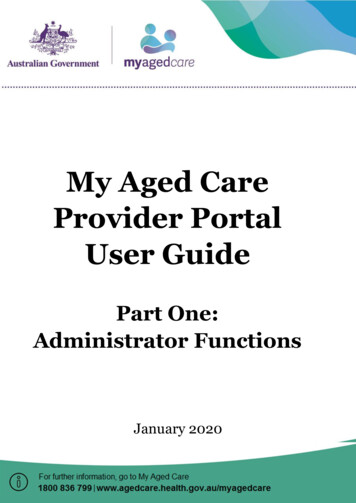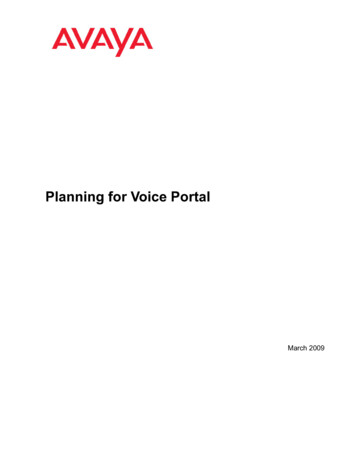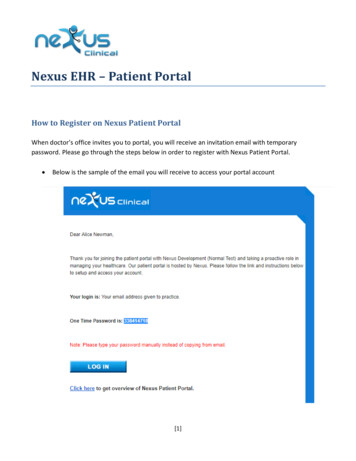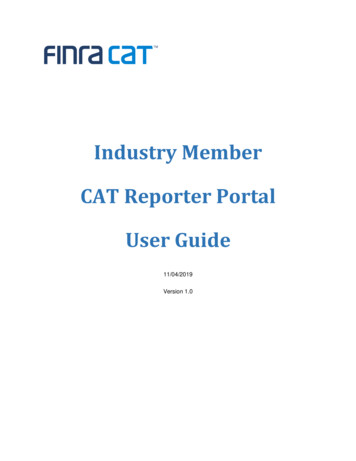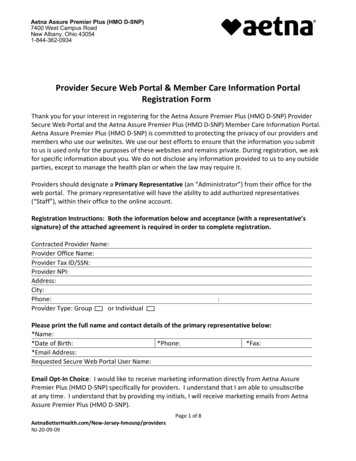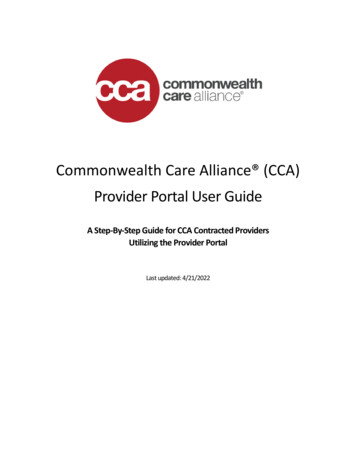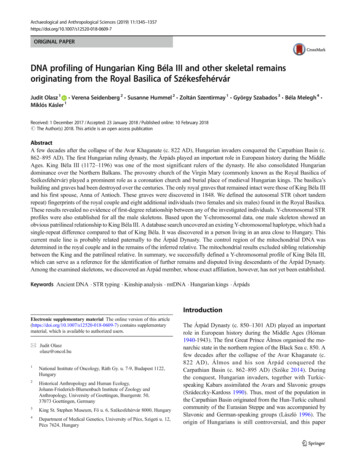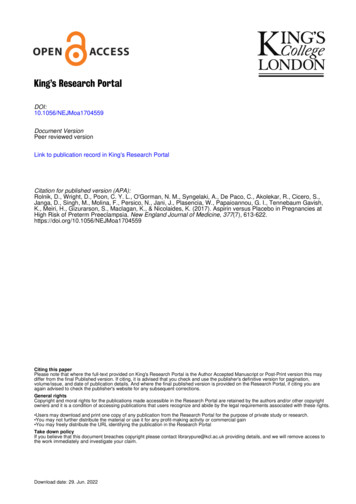
Transcription
King’s Research PortalDOI:10.1056/NEJMoa1704559Document VersionPeer reviewed versionLink to publication record in King's Research PortalCitation for published version (APA):Rolnik, D., Wright, D., Poon, C. Y. L., O'Gorman, N. M., Syngelaki, A., De Paco, C., Akolekar, R., Cicero, S.,Janga, D., Singh, M., Molina, F., Persico, N., Jani, J., Plasencia, W., Papaioannou, G. I., Tennebaum Gavish,K., Meiri, H., Gizurarson, S., Maclagan, K., & Nicolaides, K. (2017). Aspirin versus Placebo in Pregnancies atHigh Risk of Preterm Preeclampsia. New England Journal of Medicine, 377(7), g this paperPlease note that where the full-text provided on King's Research Portal is the Author Accepted Manuscript or Post-Print version this maydiffer from the final Published version. If citing, it is advised that you check and use the publisher's definitive version for pagination,volume/issue, and date of publication details. And where the final published version is provided on the Research Portal, if citing you areagain advised to check the publisher's website for any subsequent corrections.General rightsCopyright and moral rights for the publications made accessible in the Research Portal are retained by the authors and/or other copyrightowners and it is a condition of accessing publications that users recognize and abide by the legal requirements associated with these rights. Users may download and print one copy of any publication from the Research Portal for the purpose of private study or research. You may not further distribute the material or use it for any profit-making activity or commercial gain You may freely distribute the URL identifying the publication in the Research PortalTake down policyIf you believe that this document breaches copyright please contact librarypure@kcl.ac.uk providing details, and we will remove access tothe work immediately and investigate your claim.Download date: 29. Jun. 2022
Then e w e ng l a n d j o u r na lofm e dic i n eOriginal ArticleAspirin versus Placebo in Pregnanciesat High Risk for Preterm PreeclampsiaDaniel L. Rolnik, M.D., David Wright, Ph.D., Liona C. Poon, M.D.,Neil O’Gorman, M.D., Argyro Syngelaki, Ph.D., Catalina de Paco Matallana, M.D.,Ranjit Akolekar, M.D., Simona Cicero, M.D., Deepa Janga, M.D.,Mandeep Singh, M.D., Francisca S. Molina, M.D., Nicola Persico, M.D.,Jacques C. Jani, M.D., Walter Plasencia, M.D., George Papaioannou, M.D.,Kinneret Tenenbaum‑Gavish, M.D., Hamutal Meiri, Ph.D.,Sveinbjorn Gizurarson, Ph.D., Kate Maclagan, Ph.D.,and Kypros H. Nicolaides, M.D. A BS T R AC TBACKGROUNDPreterm preeclampsia is an important cause of maternal and perinatal death andcomplications. It is uncertain whether the intake of low-dose aspirin during pregnancy reduces the risk of preterm preeclampsia.METHODSIn this multicenter, double-blind, placebo-controlled trial, we randomly assigned1776 women with singleton pregnancies who were at high risk for preterm preeclampsia to receive aspirin, at a dose of 150 mg per day, or placebo from 11 to14 weeks of gestation until 36 weeks of gestation. The primary outcome was delivery with preeclampsia before 37 weeks of gestation. The analysis was performedaccording to the intention-to-treat principle.RESULTSA total of 152 women withdrew consent during the trial, and 4 were lost to followup, which left 798 participants in the aspirin group and 822 in the placebo group.Preterm preeclampsia occurred in 13 participants (1.6%) in the aspirin group, ascompared with 35 (4.3%) in the placebo group (odds ratio in the aspirin group,0.38; 95% confidence interval, 0.20 to 0.74; P 0.004). Results were materiallyunchanged in a sensitivity analysis that took into account participants who hadwithdrawn or were lost to follow-up. Adherence was good, with a reported intakeof 85% or more of the required number of tablets in 79.9% of the participants.There were no significant between-group differences in the incidence of neonataladverse outcomes or other adverse events.CONCLUSIONSTreatment with low-dose aspirin in women at high risk for preterm preeclampsiaresulted in a lower incidence of this diagnosis than placebo. (Funded by theEuropean Union Seventh Framework Program and the Fetal Medicine Foun dation; EudraCT number, 2013-003778-29; Current Controlled Trials number,ISRCTN13633058.)From King’s College Hospital (D.L.R.,L.C.P., N.O., A.S., R.A., K.H.N.), HomertonUniversity Hospital (S.C.), North Middlesex University Hospital (D.J.), and University College London ComprehensiveClinical Trials Unit (K.M.), London, University of Exeter, Exeter (D.W.), MedwayMaritime Hospital, Gillingham (R.A.),and Southend University Hospital, Westcliff-on-Sea (M.S.) — all in the UnitedKingdom; Chinese University of HongKong, Hong Kong (L.C.P.); Hospital ClínicoUniversitario Virgen de la Arrixaca, Murcia(C.P.M.), Hospital Universitario San Cecilio, Granada (F.S.M.), and Hospiten Group,Tenerife (W.P.) — all in Spain; OspedaleMaggiore Policlinico, Milan (N.P.); University Hospital Brugmann, UniversitéLibre de Bruxelles, Brussels (J.C.J.); AttikonUniversity Hospital, Athens (G.P.); RabinMedical Center, Petach Tikva (K.T.-G.),and HyLabs Diagnostics, Rehovot (H.M.)— both in Israel; and University of Iceland, Reykjavik (S.G.). Address reprintrequests to Dr. Nicolaides at the HarrisBirthright Research Centre for Fetal Medicine, Fetal Medicine Research Institute,King’s College Hospital, Denmark Hill,London SE5 8BB, United Kingdom, or at k ypros@ fetalmedicine . com.Drs. Poon and Nicolaides contributedequally to this article.This article was published on June 28, 2017,and updated on July 12, 2017, at NEJM.org.DOI: 10.1056/NEJMoa1704559Copyright 2017 Massachusetts Medical Society.n engl j med nejm.org The New England Journal of MedicineDownloaded from nejm.org at GE HEALTHCARE LTD. on July 28, 2017. For personal use only. No other uses without permission.Copyright 2017 Massachusetts Medical Society. All rights reserved.1
ThePn e w e ng l a n d j o u r na lreeclampsia is an important causeof death and complications for the motherand baby. The risk of such complicationsis considerably higher when the disease is severeand of early onset, leading to preterm birth at lessthan 37 weeks of gestation.1-4 Major challengesin modern obstetrics are the identification ofwomen at high risk for preterm preeclampsiaearly in pregnancy and interventions to reducethe prevalence of the disease.In 1979, a study showed that women who hadtaken aspirin regularly during pregnancy wereless likely to have preeclampsia than womenwho had not.5 In the subsequent decades, morethan 30 trials have investigated the benefit of lowdose aspirin (at a dose of 50 to 150 mg per day)for the prevention of preeclampsia; a meta-analysis of these studies showed that such therapyresulted in a 10% lower incidence of preeclampsia.6 In a meta-analysis of individual-participantdata from the trials, the effect of aspirin was notaffected by the gestational age at the onset oftherapy.7 In contrast, other meta-analyses showedthat aspirin started at or before 16 weeks ofgestation resulted in halving the rates of preeclampsia, fetal-growth restriction, and perinatal death, whereas aspirin started after 16 weeksof gestation did not have a significant benefit.8,9In addition, the beneficial effect of aspirin thatwas started at or before 16 weeks of gestationwas dose dependent, with a greater reduction inthe incidence of preeclampsia being associatedwith a daily dose of aspirin of 100 mg or more.10Professional associations now recommend theprophylactic use of low-dose aspirin (60 to 80 mgper day) in women who are considered to be athigh risk for preeclampsia. In the United Kingdom, the National Institute for Health and Clinical Excellence recommends the identification ofthe high-risk group on the basis of 10 factors,including maternal characteristics and featuresof the medical and obstetrical histories.11 However, the performance of such screening is poor,with detection of approximately 40% of cases ofpreterm preeclampsia and 33% of cases of termpreeclampsia, at a screen-positive rate of 11%.12In the United States, the American College ofObstetricians and Gynecologists recommendsthe use of aspirin in women with a history ofpreeclampsia in more than one pregnancy or ahistory of preeclampsia that resulted in delivery2ofm e dic i n ebefore 34 weeks of gestation.13 However, thissubgroup constitutes only approximately 0.3% ofall pregnancies and includes only 5% of womenin whom preterm preeclampsia develops and 2%of those in whom term preeclampsia develops.14An alternative approach to screening is the useof Bayes’ theorem to combine the a priori riskfrom maternal factors with biophysical and biochemical measurements obtained at 11 to 13 weeksof gestation. A study involving approximately60,000 women with singleton pregnancies showedthat such screening detected 76% of cases ofpreterm preeclampsia and 38% of cases of termpreeclampsia, at a screen-positive rate of 10%.15The Combined Multimarker Screening and Randomized Patient Treatment with Aspirin for Evidence-Based Preeclampsia Prevention (ASPRE) trialwas designed to test the hypothesis that, amongwomen who are identified as being at high riskfor preterm preeclampsia on the basis of theabove-mentioned factors, aspirin at a dose of150 mg per day, taken from 11 to 14 weeks ofgestation until 36 weeks of gestation, would result in an incidence of preterm preeclampsia thatwas half the incidence observed with placebo.Me thodsTrial Design and ParticipantsIn this double-blind, placebo-controlled trial, wecompared aspirin at a dose of 150 mg per daywith placebo that was administered from 11 to14 weeks of gestation until 36 weeks of gestation in women with singleton pregnancies whowere at high risk for preterm preeclampsia. Weconducted the trial at 13 maternity hospitals inthe United Kingdom, Spain, Italy, Belgium,Greece, and Israel.All the women who had a routine prenatal visitat 11 weeks 0 days of gestation through 13 weeks6 days of gestation in the participating hospitalswere offered screening for preeclampsia by meansof an algorithm that combines maternal factors,mean arterial pressure, uterine-artery pulsatilityindex, and maternal serum pregnancy-associatedplasma protein A and placental growth factor.(The algorithm is provided in the SupplementaryAppendix, available with the full text of this article at NEJM.org.)15Gestational age was determined from themeasurement of the fetal crown–rump length.16n engl j med nejm.org The New England Journal of MedicineDownloaded from nejm.org at GE HEALTHCARE LTD. on July 28, 2017. For personal use only. No other uses without permission.Copyright 2017 Massachusetts Medical Society. All rights reserved.
Aspirin vs. Placebo for Preterm PreeclampsiaMaternal characteristics and medical and obstetrical histories were recorded, and the maternalweight and height were measured. The meanarterial pressure was measured by validated automated devices with the use of a standardizedprotocol.17 Transabdominal color Doppler ultrasonography was used to measure the left andright uterine-artery pulsatility index, and theaverage value was recorded.18 Serum concentrations of pregnancy-associated plasma protein Aand placental growth factor were measured by anautomated device (PAPP-A and PlGF 1-2-3 kits andDELFIA Xpress random access platform, Perkin Elmer). Quality control was applied to achieveconsistency of the measurement of biomarkersacross trial centers. Quality control of screeningand verification of adherence to the protocolwere performed by the University College LondonComprehensive Clinical Trials Unit.Inclusion criteria for the trial were the following: an age of 18 years or more, singleton pregnancy, live fetus at the time that scanning wasperformed at 11 to 13 weeks of gestation, and ahigh risk ( 1 in 100) for preterm preeclampsiaaccording to the screening algorithm. Exclusioncriteria were the following: unconscious or severe ly ill status, learning difficulties or serious mental illness, major fetal abnormality identified atthe time that scanning was performed at 11 to13 weeks of gestation, regular treatment withaspirin within 28 days before screening, bleedingdisorder such as von Willebrand’s disease, pepticulceration, hypersensitivity to aspirin, long-termuse of nonsteroidal antiinflammatory medication,and participation in another drug trial within28 days before screening. Potential trial participants were given written information about thetrial, and those who agreed to participate provided written informed consent.Approval for the trial was obtained from therelevant research ethics committee and competent authority in each country in which the trialwas conducted. The trial was conducted withfidelity to the protocol, which is available, withthe statistical analysis plan, at NEJM.org. Thefunding organizations and the companies thatsupplied and distributed the aspirin and placebohad no role in the trial design, the collection,analysis, or interpretation of the data, the writing of the manuscript, or the decision to submitthe manuscript for publication. The authors vouchfor the accuracy and completeness of the dataand analyses.Randomization and Trial-Group AssignmentEligible women were randomly assigned, in a 1:1ratio, with the use of a Web-based system (SealedEnvelope), to receive either aspirin or placebo,and in the random-sequence generation therewas stratification according to participating center. The aspirin and placebo tablets were manufactured by Actavis UK and were packaged, labeled,stored, and distributed by Mawdsley-Brooks. Theplacebo tablets were identical to the aspirin tablets with respect to variables such as size, thickness, physical properties, and appearance. Afterrandomization, the participants were prescribedthe assigned trial product and received instructions to take one tablet every night throughoutthe trial and to stop taking tablets at 36 weeksof gestation or, in the event of early delivery, atthe onset of labor.Outcome MeasuresThe primary outcome measure was delivery withpreeclampsia before 37 weeks of gestation. Preeclampsia was defined according to the International Society for the Study of Hypertension inPregnancy (see the Supplementary Appendix).19Secondary outcomes were adverse outcomes ofpregnancy before 34 weeks of gestation, before37 weeks of gestation, and at or after 37 weeksof gestation; stillbirth or neonatal death; deathand neonatal complications; neonatal therapy;and poor fetal growth (birth weight below the 3rd,5th, or 10th percentile) (Table S1 in the Supplementary Appendix).20Adverse Events and AdherenceAdverse events and adherence were assessedand recorded at follow-up clinical visits at 19 to24 weeks of gestation, 32 to 34 weeks of gestation, and 36 weeks of gestation and during threetelephone interviews, which occurred at 16 weeksand 28 weeks of gestation and 30 days after thelast tablet was taken. Participants were encouraged to record any side effects or adverse eventsin a diary that was reviewed at each trial visit,and they were specifically asked about suchevents during each telephone interview.We assessed adherence by counting the tablets that were returned by participants at eachn engl j med nejm.org The New England Journal of MedicineDownloaded from nejm.org at GE HEALTHCARE LTD. on July 28, 2017. For personal use only. No other uses without permission.Copyright 2017 Massachusetts Medical Society. All rights reserved.3
Then e w e ng l a n d j o u r na lvisit and by the participants’ reporting of tabletcounts during each telephone interview. Thetotal number of tablets taken was calculated bysubtracting the number of tablets returnedfrom the number of tablets prescribed. Adherence was considered to be good if the reportedintake of tablets was 85% or more of the totalnumber that participants were expected to havetaken between the date of randomization andthe date of the visit at 36 weeks of gestation orthe date of delivery if delivery occurred before36 weeks of gestation. Adherence was considered to be moderate if the intake was between50% and 84.9% and considered to be poor if itwas less than 50%.Statistical AnalysisThe sample-size estimation was based on theassumption that first-trimester screening woulddetect 76% of the cases of preterm preeclampsiaat a screen-positive rate of 10%.15 It was hypothesized that low-dose aspirin would result in a rateof preterm preeclampsia that was 50% lowerthan the rate with placebo,8,9 for an estimatedrate of 7.6% in the placebo group and 3.8% inthe aspirin group. We calculated that the enrollment of 1600 participants would give the trial90% power to show a treatment effect at a twosided alpha level of 5%. The target recruitmentnumber was inflated to 1776 to account forattrition.Statistical analyses were performed on anintention-to-treat basis, and no interim analyseswere performed. Logistic-regression analysis wasused to determine the significance of the betweengroup difference in the incidence of pretermpreeclampsia, with adjustment for the effect ofthe estimated risk of preeclampsia at screeningand the participating center. The treatment effect was quantified as the odds ratio with a 95%confidence interval in the aspirin group. Prespecified analyses were also performed in subgroups that were categorized according to theestimated risk of preterm preeclampsia and history of preeclampsia; a post hoc subgroup analysis was performed according to country of theparticipating centers. A sensitivity analysis wasperformed to take into account the effect ofwithdrawal of consent and loss to follow-up. Wealso produced Kaplan–Meier estimates of thecumulative incidence of preeclampsia according4ofm e dic i n eto trial group, in which deliveries that were notwith preeclampsia were excluded. The treatmenteffect for the secondary outcomes was quantified as the odds ratio with a 99% confidenceinterval in the aspirin group, with adjustmentfor the effect of the estimated risk for preeclampsia at screening and the participatingcenter, and no corrections were made for multiple comparisons. The statistical software package R was used for data analyses.21R e sult sTrial ParticipantsThe trial started at King’s College Hospital, in theUnited Kingdom, in April 2014 but was stoppedin June 2014 after the recruitment of 56 participants because of administrative problems withthe supply of the trial products. The manufacture and composition of the products were thesame throughout the trial, and the women whowere enrolled during this period were includedin the trial population. The trial was restartedin July 2015, and recruitment was completed inApril 2016.A total of 26,941 women with singleton pregnancies underwent screening,15 and 2971 (11.0%)were found to be at high risk for preterm preeclampsia. However, 332 of these women (11.2%)were excluded from recruitment to the trial because they did not fulfill the eligibility criteria(Fig. 1). Of the 2641 eligible women, 1776 (67.2%)agreed to participate in the trial. After randomization, 152 women (8.6%) withdrew consent. Ofthe women who participated in the trial, 4 werelost to follow-up.There were no significant differences betweenthe aspirin group and the placebo group withregard to the characteristics of the participantsat baseline (Table 1). In the aspirin group, therewere 11 miscarriages before 24 weeks of ges tation, 2 pregnancy terminations for fetal abnormalities at or before 24 weeks of gestation,1 pregnancy termination for severe fetal growthrestriction and preeclampsia at 24 weeks of gestation, 7 stillbirths at or after 24 weeks of gestation, 1 neonatal death within 28 days after birth,and 776 live births of infants who survived untildischarge from the hospital. In the placebogroup, there were 12 miscarriages before 24 weeksof gestation, 4 pregnancy terminations for fetaln engl j med nejm.org The New England Journal of MedicineDownloaded from nejm.org at GE HEALTHCARE LTD. on July 28, 2017. For personal use only. No other uses without permission.Copyright 2017 Massachusetts Medical Society. All rights reserved.
Aspirin vs. Placebo for Preterm Preeclampsia26,941 Women were screened for pretermpreeclampsia2971 (11.0%) Were at high risk for pretermpreeclampsia332 Were excluded253 Were receiving aspirin47 Had hypersensitivity to aspirin17 Had peptic ulcer or bleeding disorder10 Participated in another drug trial2 Had miscarriage before randomization3 Had termination of pregnancybefore randomization2641 Were eligible for inclusion865 Declined to participate1776 Underwent randomization878 Were assigned to receive aspirin898 Were assigned to receive placebo74 Withdrew consent2 Were lost to follow-up78 Withdrew consent2 Were lost to follow-up798 Were included in the primary analysis822 Were included in the primary analysisFigure 1. Screening, Randomization, and Follow-up.abnormalities at or before 24 weeks of gestation,no pregnancy terminations for severe fetal growthrestriction and preeclampsia at 24 weeks of gestation, 12 stillbirths at or after 24 weeks ofgestation, 2 neonatal deaths within 28 days afterbirth, and 792 live births of infants who survivedto discharge from the hospital.Primary OutcomePreterm preeclampsia occurred in 13 of 798 participants (1.6%) in the aspirin group, as comparedwith 35 of 822 (4.3%) in the placebo group (adjusted odds ratio in the aspirin group, 0.38; 95%confidence interval, 0.20 to 0.74; P 0.004) (Ta-ble 2). The size of the treatment effect was consistent across estimated risk groups at the timeof screening, across groups defined according toobstetrical history, and across countries of theparticipating centers (Figs. S1 and S2 in the Supplementary Appendix). The cumulative percentages of participants who had delivery with preeclampsia are shown in Figure 2.Of the 152 women who withdrew consent, 74did not want any of their data to be reported and78 allowed reporting of their screening data; thebaseline characteristics of the women who withdrew consent were similar between those assigned to receive aspirin and those assigned ton engl j med nejm.org The New England Journal of MedicineDownloaded from nejm.org at GE HEALTHCARE LTD. on July 28, 2017. For personal use only. No other uses without permission.Copyright 2017 Massachusetts Medical Society. All rights reserved.5
Then e w e ng l a n d j o u r na lofm e dic i n eTable 1. Characteristics of the Trial Participants.*CharacteristicAspirin Group(N 798)Placebo Group(N 822)12.712.612.3–13.112.3–13.0Gestational age at randomization — wkMedianInterquartile rangeAge — –31.123.0–31.5White528 (66.2)559 (68.0)Black208 (26.1)201 (24.5)Interquartile rangeBody-mass index†MedianInterquartile rangeRace or ethnic group — no. (%)‡South Asian37 (4.6)37 (4.5)East Asian13 (1.6)16 (1.9)Mixed race12 (1.5)9 (1.1)747 (93.6)779 (94.8)Method of conception — no. (%)NaturalAssisted by use of ovulation drugsIn vitro fertilization6 (0.8)7 (0.9)45 (5.6)36 (4.4)Cigarette smoking — no. (%)57 (7.1)59 (7.2)Mother had preeclampsia — no. (%)66 (8.3)74 (9.0)49 (6.1)61 (7.4)Medical history — no. (%)Chronic hypertensionSystemic lupus erythematosus3 (0.4)1 (0.1)Antiphospholipid syndrome2 (0.3)2 (0.2)Diabetes mellitus type 17 (0.9)2 (0.2)Diabetes mellitus type 28 (1.0)8 (1.0)Nulliparous547 (68.5)543 (66.1)Multiparous without preeclampsia164 (20.6)195 (23.7)87 (10.9)84 (10.2)Obstetrical history — no. (%)Multiparous with preeclampsiaInterval from last pregnancy — yrMedianInterquartile rangeGestational age at delivery of last pregnancy — wkRisk of preterm preeclampsia as assessed at screeningat 11–13 wk (95% CI) — %§4.24.62.5–7.02.9–7.539 (37–40)39 (36–40)2.3 (1.4–4.8)2.6 (1.5–4.8)* There were no significant between-group differences with regard to the characteristics at baseline. CI denotes confidenceinterval.† The body-mass index is the weight in kilograms divided by the square of the height in meters.‡ Race or ethnic group was reported by the participants.§ The risk of preterm preeclampsia was assessed by means of an algorithm that combined maternal factors, mean arterialpressure, uterine-artery pulsatility index, and maternal serum pregnancy-associated plasma protein A and placentalgrowth factor (see the Supplementary Appendix).6n engl j med nejm.org The New England Journal of MedicineDownloaded from nejm.org at GE HEALTHCARE LTD. on July 28, 2017. For personal use only. No other uses without permission.Copyright 2017 Massachusetts Medical Society. All rights reserved.
Aspirin vs. Placebo for Preterm PreeclampsiaTable 2. Outcomes According to Trial Group.OutcomeAspirin Group(N 798)Placebo Group(N 822)Odds Ratio(95% or 99% CI)*13 (1.6)35 (4.3)0.38 (0.20–0.74)32 (4.0)53 (6.4)0.62 (0.34–1.14)3 (0.4)15 (1.8)0.18 (0.03–1.03)Primary outcome: preterm preeclampsia at 37 wk ofgestation — no. (%)Secondary outcomes according to gestational ageAdverse outcomes at 34 wk of gestationAny — no. (%)Preeclampsia — no. (%)Gestational hypertension — no. (%)2 (0.3)2 (0.2)1.02 (0.08–13.49)7/785 (0.9)14/807 (1.7)0.53 (0.16–1.77)14 (1.8)19 (2.3)0.78 (0.31–1.95)Abruption without preeclampsia — no. (%)1 (0.1)3 (0.4)0.36 (0.02–7.14)Spontaneous delivery without preeclampsia— no. (%)12 (1.5)12 (1.5)1.07 (0.37–3.10)79 (9.9)116 (14.1)0.69 (0.46–1.03)Small-for-gestational-age status withoutpreeclampsia — no./total no. (%)†Miscarriage or stillbirth without preeclampsia— no. (%)Adverse outcomes at 37 wk of gestationAny — no. (%)Gestational hypertension — no. (%)8 (1.0)7 (0.9)1.19 (0.31–4.56)17/785 (2.2)18/807 (2.2)1.01 (0.42–2.46)14 (1.8)19 (2.3)0.78 (0.31–1.95)Abruption without preeclampsia — no. (%)2 (0.3)4 (0.5)0.52 (0.06–4.91)Spontaneous delivery without preeclampsia— no. (%)40 (5.0)49 (6.0)0.83 (0.47–1.47)178 (22.3)171 (20.8)1.12 (0.82–1.54)53 (6.6)59 (7.2)0.95 (0.57–1.57)Small-for-gestational-age status withoutpreeclampsia — no./total no. (%)†Miscarriage or stillbirth without preeclampsia— no. (%)Adverse outcomes at 37 wk of gestationAny — no. (%)Preeclampsia — no. (%)Gestational hypertension — no. (%)72 (9.0)62 (7.5)1.24 (0.78–1.98)54/785 (6.9)56/807 (6.9)1.00 (0.60–1.66)Stillbirth without preeclampsia — no. (%)2 (0.3)2 (0.2)1.01 (0.08–13.40)Abruption without preeclampsia — no. (%)2 (0.3)2 (0.2)1.05 (0.08–13.92)Small-for-gestational-age status withoutpreeclampsia — no./total no. (%)†* The confidence interval was 95% for the primary outcome and 99% for the secondary outcomes.† The status of being small for gestational age was defined as a birth weight below the 5th percentile. The birth weightfor neonates delivered before 24 weeks of gestation was not recorded.receive placebo (Table S2 in the SupplementaryAppendix). A sensitivity analysis to evaluate theeffect of the withdrawals22 showed no substantive difference from the primary analysis (Fig. S3in the Supplementary Appendix).Tables 2 and 3, and in Figures S4 and S5 in theSupplementary Appendix. There was no significant between-group difference in the incidenceof any secondary outcomes, but the trial was notpowered for these outcomes.Secondary OutcomesAdverse EventsThe treatment effect for secondary outcomes, In the aspirin group, at least one serious adversequantified as the odds ratio in the aspirin group event occurred in 13 participants (1.6%) and atwith a 99% confidence interval, is shown in least one adverse event occurred in 207 particin engl j med nejm.org The New England Journal of MedicineDownloaded from nejm.org at GE HEALTHCARE LTD. on July 28, 2017. For personal use only. No other uses without permission.Copyright 2017 Massachusetts Medical Society. All rights reserved.7
TheIncidence of Delivery with Preeclampsia (%)100n e w e ng l a n d j o u r na l25Placebo207515Aspirin105052500002424 26 28 30 32 34 36 38 40 422628303234363840426196272852951012Week of Gestation at DeliveryNo. at 4760734740Figure 2. Kaplan–Meier Plot of Incidence of Delivery with Preeclampsia.The gray box highlights the rate of preeclampsia before 37 weeks of gestation.Data were censored after deliveries not associated with preeclampsia. Theinset shows the same data on an enlarged y axis.pants (25.9%); in the placebo group, at least oneserious adverse event occurred in 26 participants(3.2%) and at least one adverse event occurred in210 participants (25.5%). There was no significantbetween-group difference in the incidence ofthese events (Tables S3 and S4 in the Supplementary Appendix).AdherenceAdherence was good in 1294 of 1620 participants (79.9%), moderate in 241 (14.9%), and poorin 85 (5.2%). There were no significant betweengroup differences in the degree of adherence(Table S5 in the Supplementary Appendix). Asensitivity analysis that took into account adherence to the assigned regimen is shown in FigureS6 in the Supplementary Appendix.DiscussionIn this multicenter, randomized, placebo-controlled trial involving women with singleton pregnancies who were identified by means of firsttrimester screening as being at high risk for8n engl j medofm e dic i n epreterm preeclampsia, the administration ofaspirin at a dose of 150 mg per day from 11 to14 weeks of gestation until 36 weeks of gestation was associated with a significantly lowerincidence of preterm preeclampsia than wasplacebo. There was no significant betweengroup difference in the incidence of other pregnancy complications or of adverse fetal orneonatal outcomes. However, the trial was notadequately powered for the secondary outcomes.Unlike previous trials of strategies to reducethe risk of preeclampsia among high-risk women,we identified women at high risk for preterm preeclampsia by means of combined screening withmaternal demographic characteristics and historical factors and biomarkers — a strategy thathas been shown to be superior to other currently used
In this multicenter, double-blind, placebo-controlled trial, we randomly assigned 1776 women with singleton pregnancies who were at high risk for preterm pre-eclampsia to receive aspirin, at a dose of 150 mg per day, or placebo from 11 to 14 weeks of gestation until 36 weeks of gestation. The primary outcome was de-

